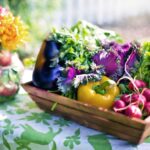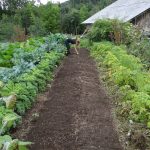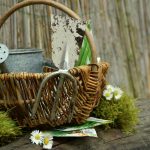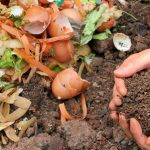It is possible to grow both flowers and vegetables in the same garden. This type of gardening is sometimes called a “flower and vegetable garden” or a “kitchen garden.” Flowers and vegetables can be grown together in the same space, allowing the gardener to enjoy both the beauty of flowers and the bounty of fresh produce.
This type of gardening can be a great way to save space, reduce water usage, and attract beneficial insects to the garden, such as bees and butterflies. When planning a flower and vegetable garden, it is important to consider the needs of both types of plants and to choose varieties that will complement each other and not compete for nutrients.
Contents
Why is it important to consider the needs of both types of plants?
It is important to consider the needs of both flowers and vegetables when growing them together because each plant will have different requirements, including the need for sunlight, water, and added nutrients.
By choosing plants that have similar requirements, you can ensure that they will all receive what they need to thrive. An example of this is planting sun-loving flowers next to shade-loving vegetables. The flowers will grow quickly and provide the vegetables with the shade that they need to grow.
Similarly, if you plant drought-tolerant flowers next to water-hungry vegetables, the vegetables will receive all the water they need to grow without sacrificing the flowers. You can have both a beautiful and productive garden just by choosing plants that work well together.
Choosing the right plants can also help attract beneficial insects like bees and butterflies to the garden. These insects are essential as they help pollinate both flowers and vegetables.

What are the benefits of growing flowers and vegetables in one garden?
There are several benefits to growing flowers and vegetables together in the same garden, including;
Saving space: by growing both flowers and vegetables in the same garden, you can save space that would otherwise be taken up by separate flower and vegetable gardens.
Reducing water usage: when you grow flowers and vegetables together, they can share water and nutrients, which means you don’t have to water them as much.
Attracting beneficial insects: many flowers attract insects that are essential to the garden, like bees and butterflies. These insects help pollinate flowers and vegetables, which makes the crops bigger and healthier.
Enhancing the garden’s aesthetic: a flower and vegetable garden can be a beautiful and colourful addition to your outdoor space. A wide variety of flowers and vegetables can add both visual interest and beauty to the garden and help you become more self-sufficient.
Provide a sense of accomplishment: Growing your own flowers and vegetables in the garden can be a fun experience, but it can also give you a huge sense of pride and accomplishment. Gardening has also been shown to have a positive effect on your mental health.

What flowers and vegetables can be planted together?
There are many flowers and vegetables that can be grown together in the same garden, and the best combinations will depend on the growing conditions as well as your personal preferences. Some flowers and vegetables that can be grown together include:
- Tomatoes and marigolds: Tomatoes and marigolds are often grown together because marigolds can help repel pests, such as nematodes, that can damage tomato plants.
- Lettuce and calendulas: Lettuce and calendulas make a great combination because calendulas can attract beneficial insects, such as bees, to the garden, which can help pollinate the lettuce.
- Carrots and dill: Carrots and dill can be grown together because dill can help repel pests, such as carrot flies, that can damage carrot plants.
- Squash and nasturtiums: Squash and nasturtiums can be grown together because nasturtiums can help to attract beneficial insects, such as bees and butterflies, which can help to pollinate the squash.
- Peas and sunflowers: Peas and sunflowers make a great combination because sunflowers can provide support for pea plants to climb on, and the sunflowers will also attract beneficial insects to the garden.
Growing flowers and vegetables together can be hugely rewarding, but it is important to research the specific growing requirements of each plant and to choose varieties that will thrive together and not compete for essential nutrients.
How much space do you need to grow flowers and vegetables?
The amount of space you will need to grow flowers and vegetables will depend on the types of plants you want to grow and the growing conditions in your garden. Some plants, such as lettuce and radishes, can be grown in small spaces, while others, such as tomatoes and squash, will need a lot more room to grow.
In general, it is recommended to allow at least 2-3 feet of space between each plant. This will give the plants enough room to grow and will also stop them from competing for sunlight, water, and other nutrients.
It is also important to consider the height and spread of the plants when deciding on the placement of your plants; tomatoes will grow vertically, so they will need to be supported somehow.
If you are growing your plants in grow bags or containers, be sure to choose bags and containers that are large enough to accommodate the plants when they reach maturity. Growing plants in pots that are too small can stunt the growth of your plants and limit their produce.
If you plan your garden in advance, you can make the most of the space you have available and create a productive and beautiful flower and vegetable garden.

Gardening tips for planting flowers and vegetables
Here are some of our best tips for planting flowers and vegetables together in the same garden:
Choose the right location
Select a location for your flower and vegetable garden that receives plenty of sunlight and has well-drained soil. Most vegetables and flowers require at least 6 hours of direct sunlight per day to grow well, so planting them in shady areas can be detrimental.
Plan your garden
Plan your garden in advance, taking into account the specific growing requirements of the plants you want to grow. Consider the height, spread, and growing season of each plant, and arrange them in a way that will allow them to thrive together.
Choose the right varieties
Choose flower and vegetable varieties that will do well together and have similar growing needs. For example, choose drought-tolerant flowers and vegetables if you live in a dry climate, or choose cool-season vegetables and flowers if you live in a region with a short growing season.
Prepare the soil
Before planting, it is essential that you prepare the soil by removing weeds, adding organic matter, and adjusting the pH to the appropriate level. Doing all of these things beforehand will help to ensure that your plants have the perfect conditions that they need to grow healthy and strong.
Plant at the proper time
Plant your flowers and vegetables at the right time of year to ensure that they receive what they need to grow well. Follow the instructions on the seed packets or plant labels for individual planting instructions.
Water and fertilise regularly
Watering and fertilising your plants regularly will ensure that they have the correct moisture and nutrients. Use a balanced fertiliser, such as a 10-10-10 formula, to provide your plants with the right mix of nutrients. Try to avoid over-watering and over-fertilizing, as this can cause problems for your plants.
Pest and disease control
Monitor your plants regularly for signs of pests and diseases and take appropriate action to control them. Try to use natural methods to get rid of pests, like attracting predatory insects or setting up traps; pesticides should be a last resort.
Why are pesticides harmful?
Pesticides are chemicals that are used to control pests, such as insects, weeds, and fungi. While pesticides can be effective at controlling pests, they can also be harmful to other plants, animals, and even humans if they are not used correctly.
Pesticides can also contaminate the soil, water, and air, which can have long-term negative effects on the environment. In addition, some pesticides can be harmful to humans if they are inhaled, ingested, or absorbed through the skin, so try to wear protective clothing and gloves when handling pesticides.
For these reasons, it is important to use pesticides only when necessary and to follow the instructions on the pesticide label carefully to avoid causing harm to yourself, the environment, or any other living things.







